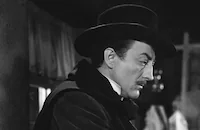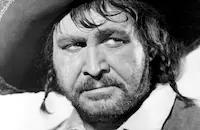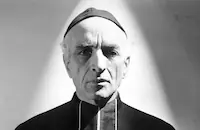The Spanish Main

Brief Synopsis
Cast & Crew
Frank Borzage
Maureen O'hara
Paul Henreid
Walter Slezak
Binnie Barnes
John Emery
Film Details
Technical Specs

Synopsis
When a Dutch ship founders off Cartagena, a Spanish seaport on the Colombian coast, the ship's captain, Laurent Van Horn, pleads with the Spanish viceroy, Don Alvarado, to allow him to repair his vessel and continue his voyage. Instead, the irascible Don Alvarado imprisons Laurent and sentences him to hang. In his cell, Laurent meets Pillory and Paree, merchant sailors who have also been unfairly imprisoned by the Spanish. Banding together, the captives overpower their guards and escape.
Five years pass, and Don Alvarado eagerly awaits the arrival of his bride-to-be, Francisca, the daughter of the Mexican viceroy, to whom he has become betrothed sight unseen. Don Alvarado's pleasure is diminished by the activities of the Barracuda , a pirate ship whose captain, known only as "The Barracuda," plunders the Spanish seas. As Francisca's ship enters the Spanish Main, she notices an attractive sailor on deck and approaches him. When the sailor insults her, Francisca orders him flogged. Soon after, the Barracuda attacks and Francisca frees the insolent sailor, who has been lashed to the mast. As the pirates swarm on board and overpower the Spanish crew, Francisca demands to meet The Barracuda and is stunned when she is introduced to the insolent sailor, Laurent. Laurent then brashly claims Francisca as his prisoner and declares that she will also be his bride.
When the San Pablo , another Spanish craft, nears, Francisca agrees willingly to marry Laurent if he spares the vessel. A bargain is struck and the marriage ceremony is performed. On their wedding night, Francisca is about to stab her groom when she yields to his embrace and drops the knife. After tucking his wife in bed, Laurent leaves the room. When the Barracuda docks at Tortuga, an aggrieved band of buccaneers led by Mario Da Bilar and Benjamin Black grumble over Laurent's marriage to Francisca, fearful that it will bring Don Alvarado's wrath upon them. Soon after, Laurent joins the gathering and is greeted by Anne Bonny, a female pirate. Upon learning of Laurent's marriage, Anne becomes jealous and draws her sword on Francisca. Undaunted, Francisca challenges Anne to a duel by pistols. When Laurent loads the weapons with chimney soot instead of gun powder, both women end up with blackened faces. Unamused, Benjamin insists that Francisca's weapon be returned to Don Alvarado, and challenges Laurent to a duel. After easily defeating Benjamin, Laurent orders him to leave the island.
Later, aboard the Barracuda , Laurent confesses his love to Francisca and proposes to her in earnest. As the couple embrace, the pirates, led by Anne and Da Bilar, burst into their cabin, commandeer the boat and announce their plans to take Francisca to Cartagena. One of the band, Captain Lussan, rows Laurent to shore in a small boat, but when they dock, Benjamin shoots Lussan and declares Laurent his prisoner. Pillory and several of Laurent's men, lolling drunkenly along the docks, witness Benjamin's treachery and come to their friend's aid. After killing Benjamin, Laurent and his men board the Cobra , a waiting ship, and sail for Cartagena.
When Francisca meets her betrothed in Cartagena, she is repulsed by his corpulence and insists upon returning home to Mexico. Denying her request, Don Alvarado schedules the wedding for the next day. Under the pretense of thanking the pirates, Don Alvarado proceeds to the Barracuda , where he orders the entire crew imprisoned. When word comes of the sighting of the Cobra , Da Bilar offers to help capture Laurent in exchange for his freedom. After the Cobra docks, Da Bilar greets Laurent and tells him that he has escaped from prison. When Da Bilar claims that Francisca betrayed Laurent and bribed the crew to sail to Cartagena, Laurent pretends to believe him. Suspecting that Da Bilar has set a trap, Laurent visits Francisca that night, hoping to be arrested and imprisoned with the other pirates. As Francisca pledges her love to Laurent, Don Alvarado's men appear and arrest him.
Disguised as a maid, Francisca visits the prisoners, delivering a basket of food laden with knives. When Don Alvarado pays a surprise visit, Francisca hides in Anne's cell. After he departs, Francisca pulls a gun on the guards and orders the release of the prisoners. Embracing Francisca, Laurent calls her his wife and then leads the men up the stairs. Hearing rumors of a woman in the cells, Da Bilar comes to investigate. When Laurent returns for Francisca, he finds Da Bilar, and the two men draw their swords. After Laurent fatally stabs Da Bilar, the guards, drawn by the sounds of the struggle, rush down the stairs and into combat with the pirates. Anne is killed in the battle, but before dying gives Francisca her blessing.
Unaware of the strife onshore, Don Alvarado is decorating the Barracuda for his wedding day when word comes of the uprising. Disguised in priest's robes, Laurent accompanies Francisca on board while the other pirates climb up the ship's bow and defeat the guards. When Laurent drops his priest's hood and Francisca declares her allegiance to the pirates, Don Alvarado realizes that his troops have disappeared and one of the pirates wounds him with a knife. After Don Alvarado staggers to a chair, Laurent gives orders to sail past the garrison along the coast. Although the soldiers at the fort have been instructed to shoot if the ship sails before morning, they peer through a telescope and see Don Alvarado and Francisca being married by a hooded priest. After firing several rounds, the soldiers relent and shoot off rockets of congratulations instead.
Once safely at sea, Francisca pleads for Don Alvarado's life, but the indolent ruler claims that he would rather be dead than forced to work, and so expires from his wounds. As the ship sails into the sunset, Laurent sweeps his bride off her feet and into their cabin below.

Director

Frank Borzage
Cast

Maureen O'hara

Paul Henreid

Walter Slezak

Binnie Barnes

John Emery

Barton Maclane

J. M. Kerrigan

Fritz Leiber

Nancy Gates

Jack Larue

Mike Mazurki

Ian Keith

Curt Bois

Antonio Moreno
Victor Kilian
Alfredo Sabato

Brandon Hurst
Bob O'connor

Tom Kennedy
Marcelle Corday
Norma Drury
Abe Dinovitch
Martha Bamattre
Bobbie Hale

James Kirkwood
Dickie Beard
Max Wagner
Ray Spiker
John Northpole
Allan Watson
Juan De La Cruz
Leo White
Charles Legneur
Cosmo Sardo
Leo Schlesinger
Jack Wise
Dan Seymour
Ray Cooper
Jamiel Hasson
Joaquin Elizondo
Carl Kent
Alf Haugan
Al Haskell
George Bruggerman
Chuck Hamilton
Jean Valjean
Demetrius Alexis
Carl Deloro
Don Avalier
Bobby Barber
Jose Portugal
Manuel Lopez
Crew
Stephen Ames
C. Bakaleinikoff
George Barnes
Lew Borzage
Claude Carpenter
Carroll Clark
Albert S. D'agostino
Ralph Dawson
William Dorfman
B. Reeves Eason
Hanns Eisler
Captain Fred Ellis Ret. B.m.m.
Robert Fellows
Natalie Kalmus
Russell Kimball
Aeneas Mackenzie
Herman J. Mankiewicz
Morgan Padelford
Lloyd Richards
Darrell Silvera
Edward Stevenson
James G. Stewart
John E. Tribby
Vernon Walker
George Worthing Yates

Photo Collections
Videos
Movie Clip


Trailer
Hosted Intro
Film Details
Technical Specs

Award Nominations
Best Cinematography
Articles
The Spanish Main
RKO's swashbuckling Technicolor hit The Spanish Main (1945) has plenty of action, lavish sets, and a juicy, change-of-pace role for Paul Henreid, who usually played the debonair womanizer in films at Warner Brothers. According to his book Ladies Man, Henreid was personally responsible for that change of pace. He came up with the story line in an attempt to change his image. "The search for challenging movies that would change my image as an actor finally made me decide to write out a quick treatment of an idea that had been simmering in my mind for a long time. I was getting tired of being cast as the suave ladies' man...so I started to think in terms of something that would be more fun, a swashbuckling part in a pirate film."
While Henreid had a lot of faith in his swashbuckling idea, the bosses at Warner Brothers didn't share his enthusiasm. In fact, Henreid says in Ladies Man that Jack Warner's response to his idea was: "Look, when I want a lover, I'll take you. When I want a pirate, I'll get Errol Flynn!" So Henreid left Warner Brothers to pitch his idea to RKO, who immediately loved it and quickly assigned a writer for the first draft. But Henreid hated the first treatment so much that he threatened to leave the studio if they didn't have the script re-written to follow his initial outline. The studio trashed the script and re-assigned the project to their top screenwriter Herman Mankiewicz, who was convinced to take on the project over an undisclosed amount of scotch.
According to Richard Merryman's biography Mank, "Sometimes Herman was hired simply as an experienced presence to reassure an insecure producer. When RKO him on its costume spectacular Spanish Main...there was already a complete script written by a young man named [George Worthing] Yates and accepted by the studio. The producer was a Wall Street broker with no previous movie knowledge but important holdings in Technicolor. Herman called him "the camel driver." Every morning Yates delivered his repolished pages, and Herman read them along with his morning mail. Sometimes, before passing them on, Herman folded in some adjectives. "Give them guff," he told Yates. "You write too bonily. The camel driver likes guff."
Henreid was delighted with the result, stating in his biography, "The script Herman did, his first adventure story, was perfect, an exciting, thrilling story with everything I wanted in it. His final scene was the slave revolt and the burning of Tortuga." Unfortunately the studio couldn't afford the elaborate finale but told Henreid, who felt so strongly about the ending, that if he put up the two hundred thousand dollars necessary to film it, they would approve it. Henreid was actually tempted to do it and approached his agent Lew Wasserman with the idea who told him flatly, "You're an actor, Paul. You're involved in the creative end of films. You shouldn't be concerned with money problems." Henreid realized Wasserman was right and relented. "So we decided to rewrite the ending," he noted in his autobiography, "and it broke my heart to leave the fire out. Herman was furious. "I gave you a terrific script, and you told me you had the power to do it, and now you want me to butcher the ending. I won't do it!"
"Someone else rewrote it," Henreid added, "and the film turned out to be a colossal success. Dore Schary, who became head of production at RKO in 1945, shortly after The Spanish Main was shot, told me that the film had grossed $14 million, and, for the time being, kept RKO alive." Critics weren't as pleased as the general public, however, and typical of their response was this posting by Bosley Crowther of The New York Times: "Paul Henreid is "dashing" as the pirate, Maureen O'Hara is "spirited" as the girl and Walter Slezak is "heinous" as the governor. They turn it on like water out of a tap. Possibly grade-school children will find it all very much to their taste."
For Maureen O'Hara, The Spanish Main was, according to her autobiography, "good swashbuckler fare, pairing me with Paul Henreid, the Austrian actor best known for his role as Victor Laszlo in Casablanca [1942]. Some in Hollywood called him "Crackerbutt Hemorrhoid" because he had no behind at all. Truthfully, he was too charming and not tough enough for the role in our film. Frank Borzage directed the picture and it was shot in Technicolor by cinematographer George Barnes. With a camera, George could make you look like milk and honey, sugar and cream." The most significant aspect of making The Spanish Main for O'Hara, however, wasn't the film itself but a reunion with director John Ford who visited the set one day. In the presence of Frank Borzage, he offered her the lead in his next movie, The Quiet Man (1952), which O'Hara was thrilled to accept and which became one of her signature and best loved roles.
The Spanish Main did garner one Oscar® nomination for Best Cinematography (it lost to Leave Her to Heaven) and its success was responsible for launching a series of Technicolor features at RKO including Sinbad the Sailor (1947), Tycoon (1947) and She Wore a Yellow Ribbon (1949). One participant in The Spanish Main's production that should have been recognized at the Academy Awards was composer Hanns Eisler whose music score for the film is one of its highlights. Paul Henreid in Ladies Man wrote that Eisler "fled to the United States in 1933 to escape Hitler, was a great friend of Brecht, and we met him and came to know him at Brecht's cafe-house. Eisler, an immensely talented man, was the musical assistant to Charlie Chaplin, and later, tragically, was forced to leave the United States during the days of the McCarthy witch-hunt. At my request he wrote a splendid score for my film The Spanish Main."
Director: Frank Borzage
Producer: Stephen Ames, Frank Borzage, Robert Fellows (executive)
Screenplay: Aeneas MacKenzie, Herman J. Mankiewicz, George Worthing Yates
Cinematography: George Barnes
Editor: Ralph Dawson
Art Direction: Carroll Clark, Albert S. D'Agostino
Music: Hanns Eisler
Cast: Paul Henreid (Capt. Laurent Van Horn), Maureen O'Hara (Contessa Francesca), Walter Slezak (Don Alvarado), Binnie Barnes (Anne Bonney), John Emery (Du Billar).
C-101m. Close captioning.
by Jeff Stafford
SOURCES:
Ladies Man by Paul Henreid
Mank: The Wit, World, and Life of Herman Mankiewicz by Richard Merryman
'Tis Herself by Maureen O'Hara
Souls Made Great Through Love and Adversity: The Film Work of Frank Borzage by Frederick Lamster

The Spanish Main
Quotes
Trivia
RKO's first color film.
Notes
The film opens with the following prologue: "The Spanish Main-cruel, oppressive and ruthless, where power alone was a man's single title to everything he held dear, including his very life. It was thus a cruel fate that a peaceful Dutch pilgrim ship should be driven by torrential waves-and crash upon the rocks immediately outside Cartagena, its most remorseless citadel." According to pre-production news items in Hollywood Reporter, Merle Oberon, Laraine Day and Margo were considered for the role of "Francisca." A news item in New York Times notes that although Maureen O'Hara, who was finally cast in the role, was under contract to Twentieth Century-Fox, she also was committed to make one picture a year for RKO.
According to another news item in New York Times, process photography on this picture had to be postponed until after principal photography was completed because a labor dispute between the local AFI union and the set designers delayed the construction of miniatures. The picture was nominated for an Academy Award for Best Color Cinematography. The character of "Anne Bonny" was based on a famous female pirate. Bonny, who sailed the seas in the early 1700s, fought in men's clothing and was considered an expert with a pistol and cutlass. Other films featuring the character Anne Bonny include the 1951 Twentieth Century-Fox production Anne of the Indies, directed by Jacques Tourneur and starring Jean Peters, and the 1995 Carolco picture Cutthroat Island, direced by Renny Harlin and starring Geena Davis.
















